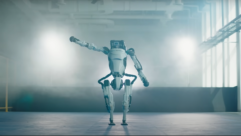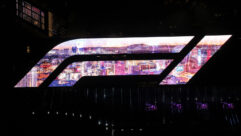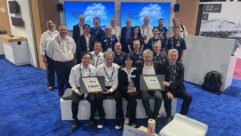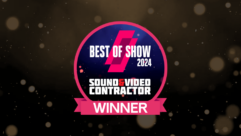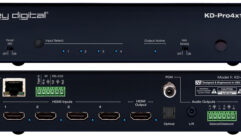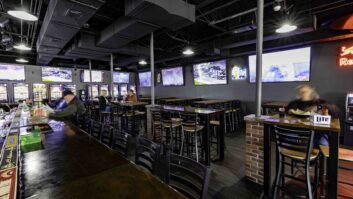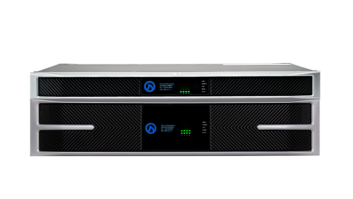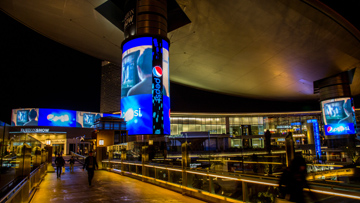
SVC Podcast – Show Notes – Show 146-2:
In this edition of the SVC Podcast, SVC Contributing Editor Bennett Liles completes his interview with Jim Vasgaard and John Howardson of Daktronics about the new LED video capable displays lighting up the plaza at Fashion Show Las Vegas. Jim and Josh detail the sound system, the construction process and discuss the content that plays continuously on the new LED video screens.
For Part 1
- Daktronics, maker of the world’s most spectacular signage
- See the video displays in action
- Las Vegas-based Best Agency that oversees network operations
- New York City-based Show+Tell content creator
- Las Vegas-based Brian Henry Design
- Houses in Motion from Brooklyn, New York
- Antfood – music and sound design
- House of Current, Atlanta based ad agency creator of Fashion Show branded images on the pylons
Download Podcast Here:
https://s3.amazonaws.com/nb-svc/public/public/Daktronics_Fashion_Show_Ve…
From Sound & Video Contractor Magazine, this is the SVC Podcast with Josh Howardson and Jim Vasgaard of Daktronics. Show notes for the podcast are on the web site of Sound & Video Contractor Magazine at svconline.com.
The competition for attention on the Las Vegas Strip is intense and it goes 24/7. Fashion Show Mall in Las Vegas called in Daktronics to give their signage a big facelift with new LED video displays. Jim Vasgaard and Josh Howardson from Daktronics are back to wrap up their story on how the whole new look was designed and installed. That’s coming up next on the SVC Podcast.
Jim and Josh, thank you for getting back with us from Daktronics on the SVC Podcast and last week we were getting into how you put new LED video displays on the Cloud, the big aluminum spaceship-looking object over the Fashion Show Mall. How are all of these new LED video displays controlled and who was behind developing all of the content that’s shown on them?
Jim: The displays are controlled by the new Daktronics platform, which is called the Venus Control Suite. And that’s the control content management system, so all of the content gets uploaded, managed and scheduled through that. [Timestamp: 1:21]
And you trained all of the operators and got them set up and going on it?
Jim: Yes, sir. We do the full gambit. We train them on how to use it and then we also support them down the path if they have ideas on hey, we’re looking to do something, can you help us out, reconfigure setup of the software and stuff like that. [Timestamp: 1:38]
That would involve some pretty long cable runs. So how do you carry the video content to the displays?
Jim: That is done over fiber optic cable from the control system out to the display and it uses proprietary Daktronics protocols and format so it’s not just a DVI or an SDI signal, it gets converted into Daktronics format and pumped out to the display. [Timestamp: 2:02]
So by the time you’re done with the local tech people on the displays and sound they know enough to handle anything that might come up in normal operation, but they can always call Daktronics if something comes up.
Jim: Yeah, that’s exactly right. We like hearing from them when they need something and we like hearing from them if they have issues or problems. And we have a full support staff here at Daktronics and there’s also local staff in Las Vegas to help support them. [Timestamp: 2:26]
Well, of course the visual is the first thing you notice at the Fashion Show Mall Plaza but there’s also a very sophisticated sound system. How many zones does it cover?
Jim: There are 20 zones, 69 speakers, and 68 amplifiers capable of around 48,000 watts.
Of course on the visuals, you can focus your attention on one display at a time and sort of zone out the others but when it comes to the sound that may be a bigger task of just keeping all of the various sound sources from just seeming like chaos.
Jim: Yeah, we spent a great deal of time. It’s a very unique sound system, especially on the Strip here in Las Vegas with all of those zones. With all the storefronts in the Plaza area, you can’t just blast them out. They also have their own systems and are competing for space. So that’s why there is this large number of zones so that everything can be adjusted and so you’re not blaring at one portion of the Plaza and they’re not loud enough on the other side. And to go along with that there’s actually, it’s also very unique is I think we have three or four profiles or presets set up in the sound system so that when – let’s say we’re running normal day content; there’s no audio in the content. This system plays background music so that there’s noises, there’s stuff happening and things pique your interest. And then when there’s an advertiser who wants audio, which is also a very unique thing to the Fashion Show on the Strip – they’re the only facility on the strip that offers this – is that they can sell your advertising with audio, so if there’s a Pepsi ad that goes up and they want audio with it, they can include that. So the sound system will change to incorporate that audio, so it will lower some channels and shape the sound. Same thing with some of the spotlights – the artist spotlights and the spectaculars, the big moments. So when the holiday spectacular ran on the top of the hour, it changes the sound of how everything around it is shaped. [Timestamp: 4:21]
One of your central partners on this was Vision Sign Company who actually put the signs up. At some point in this, did Daktronics come in and do the actual control and content connection or was that locally contracted as well?
Jim: No, that was a combination of both. Daktronics will always have an onsite install supervisor to kind of oversee the sign company and the local onsite project management. But when it comes to the finer details of configuring the control system, that’s usually someone like myself, an application engineer, or other engineers from Daktronics that will come in and configure and set everything up. [Timestamp: 5:02]
Lots of big displays on this. Was there any kind of a power constraint on what you could use in lighting everything up? I think you said the sound has something like 48,000 watts. Although I’m sure the LED displays are pretty efficient, was there a limit to what you could do on the power?
Jim: There really was no power limits because the existing signage that was onsite was removed and didn’t get put back up in the same location. So the LED on the pylons and over the south entry was all new, so the facility had to bring new power out to the displays. The only actual restrictions on the columns were due to the Cloud and the structure that was holding up the Cloud. They might be kind of hard to see in any of the pictures, but there’s wired cabling that’s run from the edges of the Cloud to the pylons basically to the top of the displays. And because that Cloud is tipped at an angle on its side, that’s why the north column is shorter than the south column display. So from the physical restrictions it was basically just based on the structure itself. [Timestamp: 6:09]
Yeah, that’s interesting the way the Cloud looks as though it could just slide down those two columns and land at any moment. So how many people did you have to coordinate on doing all of this and getting it finished within the time deadline?
Jim: I think our deadline was around the November 1 time, and we actually had everything mostly operational in the summer. So that turned out really well. From the number of people anywhere it depends on the work that was being done, but there could have been anywhere from 20-25 people working on the display or the system at any given time. There’s usually one or two Daktronics people onsite. Vision, I think they probably had a majority of the people onsite working on things. They had like a 12-man crew working in their shop, so they received all the sections of the displays and then they built those sections up a little bit and then transported them to site to be hung. Then I think there was probably anywhere from six to eight people working onsite until the installation was finished. So it was probably a four to five month installation period. Start to finish was about 18 months. And then once the displays were fully installed and operational, there was probably two or three Daktronics people onsite configuring and going through the commissioning process to check everything out and they’ll make sure everything was working the way it was supposed to. [Timestamp: 7:41]
Now these LED video displays are not identical. Is there a difference on say, the pixel pitch from one display to some of the others?
Josh: Yep. So there are some different pixel pitches. The two columns and the south entry are 15mm. The smaller anchor pylons we call them, they’re 8mm. And then on the indoor it is a 6mm. So they’re probably a very similar LED, but move closer together or further apart. [Timestamp: 8:08]
And they had some existing displays inside the Fashion Show Mall that you renovated or improved. We talked about the three displays over the Fashion Show runway. Were there others that you had to upgrade?
Josh: That was the only display. It was an LED display that we actually replaced and put in a new one. The facility does have some LCD network, but we haven’t done anything with those yet. [Timestamp: 8:32]
Josh, we’ve talked about the hardware and how it got set up but another great thing about this is of course the content that runs on the displays. Who designed and developed the content? I know it was a number of different outfits.
Josh: Yeah, work with CGP and quite a few different content producers to deliver content. Some of the content was provided by Show and Tell from New York City, with Brian Henry Designs, who’s local in Las Vegas. And they did some of the premium video images, the 3D content, and some of the Fashion Show branding. So if you’re in there looking at the displays and you see the feathers come flowing by and the waterfall coming down the displays, that was Brian Henry. We also worked with Houses in Motion, which is out of Brooklyn. Houses in Motion developed and made the holiday spectacular. That was their four-minute show that played on top of every hour through December. Houses of Current, which is out of Atlanta, they did the branded imagines and video for the mall, primarily the content shown on the anchor pylons. And then the local onsite is the Best Agency. The Best Agency does a little bit of everything for Fashion Show. They do advertiser content. They also are the group that does all the day-to-day operation. They operate the display scheduling, time management, and then they also do the video production for the fashion shows that happen in the Great Hall; so when they run the fashion shows or other live events. They host a lot of corporate events in the mall. Any time a video production happens through them. [Timestamp: 10:00]
And that’s a huge and very high-profile creative canvas for these people to do their best stuff.
Josh: It’s very unique to see for Fashion Show because the CGP has done a really good job at laying out what they wanted with the displays. They’re splitting their time between the content that they’re selling, advertising, on their business model, but they also save time to do artistic stuff. So you get to see some things that are fresh, that it’s not just an ad in your face all the time, which is really nice and refreshing. Some of the content that they’ve done they put it out on the street for local artists who are doing interesting visual video-type artwork and open that up to them. So if you see some things on the display and you don’t know exactly what it is, that’s what it is. They’ve opened it up for that artistic feel which gives it a really nice, well-rounded balance of advertising and fresh content. [Timestamp: 11:00]
Well, you don’t get much bigger display projects than on the Las Vegas Strip, but that one is up and running so what have you got in the works now? What’s coming up?
Josh: We’ve got quite a few football projects going in for the next season. We have the Atlanta Falcons. The facility is being built. The displays aren’t onsite being installed yet. That’s going to be an enormous project display that’s going to be right around 60-65,000 square feet of LED signs just in one display. And we have the Miami Dolphins. The Minnesota Vikings are just finishing their stadium and I think we just finished our install. The Cleveland Indians are doing a renovation. The University of Oklahoma football is also doing a very large renovation in, I believe, the MGM Arena. [Timestamp: 11:44]
It’s been good to hear how all of these new LED video displays got put up and configured for the Fashion Show Mall. Over ten thousand square feet of high-resolution LED video is up and running there now. Jim Vasgaard and Josh Howardson from Daktronics. When you get started on your next big football display project, get with us and take lots of pictures.
Josh: We sure will.
Jim: We will do that. We’re looking forward to it. Thank you.
Thank you for being here with us for the SVC Podcast with Jim Vasgaard and Josh Howardson from Daktronics. Show notes for this podcast are on the website of Sound & Video Contractor Magazine at svconline.com. Be back with us next week for the next SVC Podcast.


